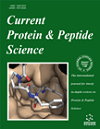- Home
- A-Z Publications
- Current Protein and Peptide Science
- Previous Issues
- Volume 19, Issue 6, 2018
Current Protein and Peptide Science - Volume 19, Issue 6, 2018
Volume 19, Issue 6, 2018
-
-
Cytotoxicity of Silver Nanoparticles Against Bacteria and Tumor Cells
More LessAuthors: Tianyuan Shi, Xuesong Sun and Qing-Yu HeWith the rapid increase of multiple drug-resistant bacteria, silver nanoparticles (AgNPs) with broad-spectrum antibacterial activities have been widely applied in the treatment of bacterial infection. Meanwhile, AgNPs also have anticancer activities against different cell lines. The toxic effects of AgNPs depend on concentration, size, shape, coated materials and surrounding environments. In order to better understand the antib Read More
-
-
-
Drug-Target Interactions: Prediction Methods and Applications
More LessIdentifying the interactions between drugs and target proteins is a key step in drug discovery. This not only aids to understand the disease mechanism, but also helps to identify unexpected therapeutic activity or adverse side effects of drugs. Hence, drug-target interaction prediction becomes an essential tool in the field of drug repurposing. The availability of heterogeneous biological data on known drug-target intera Read More
-
-
-
A Review of Computational Methods for Predicting Drug Targets
More LessAuthors: Guohua Huang, Fengxia Yan and Duoduo TanDrug discovery and development is not only a time-consuming and labor-intensive process but also full of risk. Identifying targets of small molecules helps evaluate safety of drugs and find new therapeutic applications. The biotechnology measures a wide variety of properties related to drug and targets from different perspectives, thus generating a large body of data. This undoubtedly provides a solid foundation to expl Read More
-
-
-
Non-Allosteric Cooperativity in Hemoglobin
More LessHemoglobin (Hb) is the prototypical example of a cooperative protein. Cooperativity of Hb is largely accounted for by the oxygen-linked allosteric interconversion between the T and R states/structures. Allostery is such a powerful explanation of Hb cooperativity that the possibility of cooperative events occurring within each allosteric conformation, in the absence of any quaternary structural change has usually been Read More
-
-
-
VEGF - A Stimulus for Neuronal Development and Regeneration in the CNS and PNS
More LessAuthors: Verena Theis and Carsten TheissThe vascular endothelial growth factor (VEGF) is a homodimeric disulfide bound glycoprotein that promotes endothelial growth, accompanied by higher vascular permeability, and therefore represents an important factor for angiogenesis and vascularization. In addition, VEGF also has a neurotrophic and neuroprotective impact on glial and neuronal cells within the CNS and PNS. Recently, we have shown that VEGF increa Read More
-
-
-
A Focus on the Beneficial Effects of Alpha Synuclein and a Re-Appraisal of Synucleinopathies
More LessAlpha synuclein (α-syn) belongs to a class of proteins which are commonly considered to play a detrimental role in neuronal survival. This assumption is based on the occurrence of a severe neuronal degeneration in patients carrying a multiplication of the α-syn gene (SNCA) and in a variety of experimental models, where overexpression of α-syn leads to cell death and neurological impairment. In these conditions, a hi Read More
-
-
-
Regulation of Clusterin Gene Expression
More LessAuthors: Marilina Garcia-Aranda, Alfonso Serrano and Maximino RedondoClusterin is a multifunctional glycoprotein whose role in cells has generated a great controversy in recent years. Since its discovery, numerous studies have linked clusterin expression deregulation with various physio-pathological processes such as cancer or Alzheimer's disease. Although the results of such investigations have sometimes been contradictory, mainly due to the dichotomous role of clusterin isoforms, it has b Read More
-
-
-
Current Understanding of Physicochemical Mechanisms for Cell Membrane Penetration of Arginine-rich Cell Penetrating Peptides: Role of Glycosaminoglycan Interactions
More LessAuthors: Yuki Takechi-Haraya and Hiroyuki SaitoArginine-rich cell penetrating peptides (CPPs) are very promising drug carriers to deliver membrane-impermeable pharmaceuticals, such as siRNA, bioactive peptides and proteins. CPPs directly penetrate into cells across cell membranes via a spontaneous energy-independent process, in which CPPs appear to interact with acidic lipids in the outer leaflet of the cell membrane. However, acidic lipids represent only 10 to 20% of th Read More
-
Volumes & issues
-
Volume 26 (2025)
-
Volume 25 (2024)
-
Volume 24 (2023)
-
Volume 23 (2022)
-
Volume 22 (2021)
-
Volume 21 (2020)
-
Volume 20 (2019)
-
Volume 19 (2018)
-
Volume 18 (2017)
-
Volume 17 (2016)
-
Volume 16 (2015)
-
Volume 15 (2014)
-
Volume 14 (2013)
-
Volume 13 (2012)
-
Volume 12 (2011)
-
Volume 11 (2010)
-
Volume 10 (2009)
-
Volume 9 (2008)
-
Volume 8 (2007)
-
Volume 7 (2006)
-
Volume 6 (2005)
-
Volume 5 (2004)
-
Volume 4 (2003)
-
Volume 3 (2002)
-
Volume 2 (2001)
-
Volume 1 (2000)
Most Read This Month
Article
content/journals/cpps
Journal
10
5
false
en


